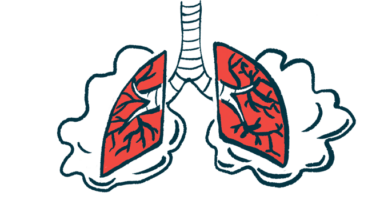Switching from Tracleer to Opsumit May Benefit Some PAH Patients

Switching from Tracleer (bosentan) to Opsumit (macitentan) improved physical abilities with fewer side effects in some adults with pulmonary arterial hypertension (PAH), a study showed.
Replacing Tracleer with Opsumit may be a feasible treatment option in PAH patients who did not fully respond to Tracleer alone or in combination with other PAH therapies, the researchers concluded.
The study, “Prospective clinical assessment of patients with pulmonary arterial hypertension switched from bosentan to macitentan (POTENT),” was published in Pulmonary Circulation.
Tracleer is a twice-daily oral treatment approved for both adults and children with PAH, which is marked by narrowing of the lung’s blood vessels, called the pulmonary arteries, and the restriction of blood flow, leading to high blood pressure.
The therapy is known as a vasodilator because it widens the blood vessels by blocking the action of endothelin-1, a molecule that potently stimulates artery narrowing and is found at abnormally high levels in PAH patients.
Although multiple clinical trials have demonstrated Tracleer’s effectiveness in slowing disease progression and improving survival, it’s been linked to significant side effects, including liver injury. As a result, lower, less effective doses may be prescribed, or patients may discontinue it.
Opsumit is a more recently developed PAH therapy that also blocks endothelin-1, but unlike Tracleer, it’s taken once daily with little impact on the liver, making it a potentially better option for some patients.
In this study, called POTENT, researchers at the King Faisal Specialist Hospital & Research Center, Saudi Arabia, followed the outcomes of 50 adults with PAH, mostly female (78%), for one year after switching from Tracleer to Opsumit.
Idiopathic or heritable PAH was diagnosed in 24 participants, PAH associated with congenital heart disease occurred in 19, five had PAH associated with connective tissue disease, while two had PAH related to pulmonary veno-occlusive disease (arterial blockages) and/or pulmonary capillary haemangiomatosis (abnormal blood vessel proliferation in the lungs).
Almost all (94%) were being treated with at least one other therapy in addition to Tracleer.
One year after switching, physical abilities improved for 26% of participants, as indicated by a shift to a lower World Health Organization functional class (WHO FC). The probability of a patient being in WHO class III/IV — moderate to severe disability — decreased from 41% to 11%.
The mean distance walked in six minutes (6MWD), an endurance test, increased by about 34 meters (almost 112 feet) over one year, with a significant mean change over time — from 12.63 meters (41 feet) at three months to 40.75 meters (nearly 134 feet) by one year.
Blood flow measures dropped over time, while heart function significantly improved over one year. No differences were seen in the percentage of red blood cells in the bloodstream (hematocrit) or hemoglobin levels, the protein that carries oxygen in red blood cells.
Notably, after one year of Opsumit, there was a significant decrease in the mean level of liver enzymes in the bloodstream — a sign of liver damage — from 39.1 to 27.3 Units/L.
There were also non-significant trends toward lower NT-proBNP, a marker for heart damage, and decreased heart rates, fatigue, and blood oxygen saturation, alongside increased markers for kidney function impairment.
Among the 50 participants, nine saw clinical worsening after one year, all of whom started other PAH therapies or had a PAH-related hospitalization. None of the participants discontinued the study or missed visits to the clinic.
Lastly, there was a 22% increase in the number of patients meeting three low-risk clinical parameters based on WHO functional class, 6MWD, and NT-proBNP. At the same time, the number of patients meeting one high-risk parameter decreased over one year (26% vs. 58%), as did the number meeting two high-risk parameters (2% vs. 20%).
“Replacing [Tracleer] with [Opsumit] is generally safe and may be a feasible treatment option in selected PAH patients who did not fully meet the low-risk stratification criteria on [Tracleer] as monotherapy or in combination with [other] pulmonary vasodilator therapy,” the researchers concluded. “We anticipate that studying this strategy in PAH subgroups would further clarify its overall potential and limitations.”








